Are you tired of making countless cold calls only to hear the dial tone or face rejection? Does the mere mention of “cold calling” conjure images of endless hours spent on the phone with little to show?
Many sales professionals are in this frustrating cycle where traditional methods seem ineffective.
Perhaps you’re like Sarah, a dedicated sales rep who diligently calls prospects daily but struggles to connect meaningfully. Or maybe you resonate with John, whose detailed, crafted pitches often fall flat, leaving him wondering where he went wrong.
If cold calling isn’t yielding the desired results, or if you want to execute it for your new business, it might be time to build your strategy for success.
What if I share proven cold-calling techniques and tools that build connections and transform your sales trajectory? Whether you’re a seasoned sales professional or new to cold calling, read on to elevate your outreach efforts and achieve measurable results.
What is cold calling?
Cold calling is a telemarketing strategy where salespeople contact potential customers without prior interaction with them. It’s one of the oldest forms of marketing. Unlike cold calling, warm calling involves reaching out to individuals who have previously shown interest in the product or company.
Even for skilled professionals, cold calling has a low success rate, typically around 2%. The practice has declined in the U.S. due to regulations like the FCC’s restrictions on calling cell phones without consent and the national Do Not Call registry.
Also, customers generally dislike cold calling, which leads to laws making it more difficult. Cold calling faces challenges from more effective methods like email, text, and social media marketing.
Success in cold calling requires persistence and resilience against rejection.
Timing plays a significant role in the success of cold calling. Specifically, reaching out to prospects between 4 and 5 PM is 71% more effective than calling between 11 AM and 12 PM (source). Late afternoon calls catch prospects at a more receptive time.
A study highlights that B2B tech sales representatives should aim for at least 60 daily calls to optimize their chances of securing meetings (source). However, most reps fall short of this benchmark, averaging only about 35 daily calls, roughly half the recommended amount.
Take care of your customers better than before. Try HelpDesk for free and join our 14-day trial. 🚀
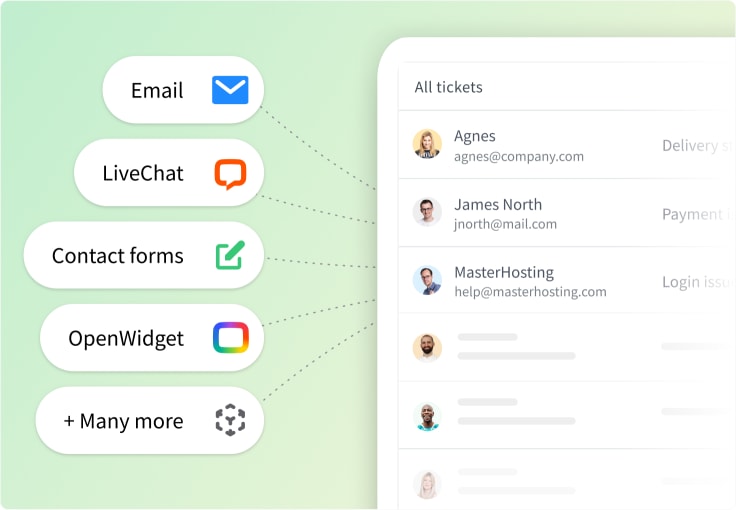
How does cold calling work?
-
Method: This cold calling process involves phone solicitation and includes in-person visits.
-
Research: Successful cold callers research their prospects to identify likely respondents.
-
Attrition: High attrition rates are expected in professions that rely heavily on cold calling due to its difficulty.
Examples of cold calling
Cold calling can be found in various industries, each with unique approaches and techniques. Here are some examples:
-
Finance industry: Brokers contact potential clients via cold calls, hoping to pitch investment opportunities and gain new clients.
-
Software sales: Sales reps call businesses to introduce new software solutions, aiming to schedule product demonstrations and secure sales.
-
Insurance sales: Agents contact potential clients to discuss insurance plans and policies, seeking to expand their customer base.
-
Home products: Salespeople go door-to-door in neighborhoods to demonstrate and sell high-end home appliances like vacuum cleaners.
Build long-lasting relationships with your buyer. 🤝 Automate your sales processes and improve response times with HelpDesk for Sales. 👏

Pre-call preparation
Cold calling can be an effective sales tool, but success depends on thorough pre-call preparation, including working on the script and identifying the right contacts.
1. Research potential customers
The first step in preparing for cold calls is to research potential clients. This helps to avoid awkward situations and ensures that your call is pertinent to the potential customer.
-
Understand the prospect’s background: Gather basic information about the potential customer. Include their industry, company size, location, and any recent news or events related to their business. It provides context, and you can customize the pitch accordingly.
-
Check eligibility: Before making the call, check if the prospect is eligible for your product or service. For example, if you’re selling enterprise software, you should verify that the company meets specific criteria, such as the number of employees or annual revenue. That saves time on leads that are likely to convert.
-
Identify pain points: Use resources such as company websites, news articles, and social media profiles to identify potential challenges the prospect might be experiencing, understand them, and position your product or service as a solution to their problems.
-
Personalization: Find out any personal or professional details about the prospect that can help build rapport. It can include their role within the company, recent achievements, or shared connections.
2. Write a cold-calling script
Having a well-prepared script is crucial for cold calling. It keeps the sales team on track and minimizes errors. Elements of an effective cold-calling script include:
-
Introduction: Start with a concise and friendly introduction, mentioning your name, company, and a brief reason for the call, setting the tone and context for the conversation.
-
Value proposition: Quickly move to your value proposition. A short statement highlights the key benefits of your product or service. Focus on how it can solve a problem or improve the prospect’s situation.
-
Qualifying questions: Include a few qualifying questions to determine if the prospect is a good fit for your offering. These questions should be open-ended to encourage conversation.
-
Address objections: Prepare responses to common objections. This helps you handle pushback smoothly and keep the conversation on track.
-
Call to action: End with a clear call to action. It could be scheduling a follow-up meeting, sending more information, or demonstrating.
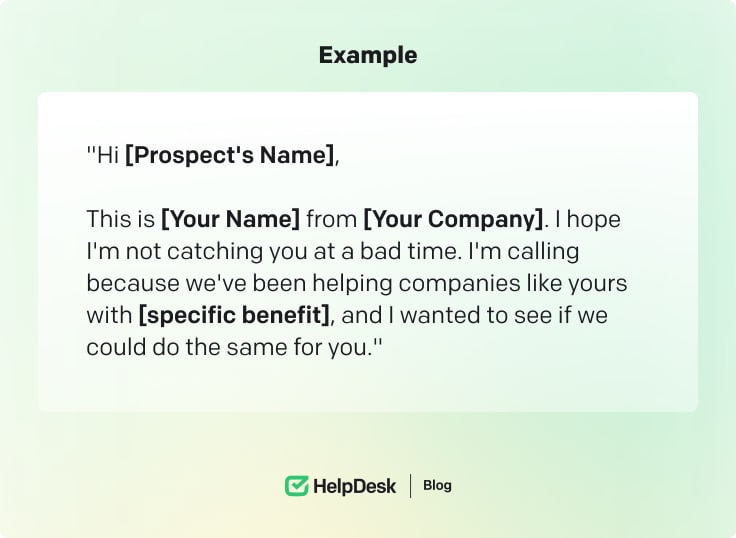
3. Identify the right person to call
Finding the right contact person is a must for the success of your cold-calling efforts. Here’s how to identify the key decision-makers:
-
Target job titles: Focus on job titles that are likely to have the authority to make purchasing decisions. Depending on your product or service, this might include roles such as managers, directors, or C-level executives.
-
Use online resources: Use platforms like LinkedIn to gather information about potential contacts. LinkedIn allows you to search for individuals based on their job titles, company, and other criteria. It can help you create a list of relevant contacts.
-
Analyze organizational structure: Some companies provide information about their organizational structure on their websites. Understanding who reports to whom can help you identify the right person to contact.
-
Network and referrals: Use your existing network to get referrals or introductions to the right contacts. A warm introduction can significantly increase your chances of success.
-
Engage gatekeepers: When calling a company, you may need to engage with gatekeepers like receptionists or administrative assistants. Be polite and concise, and try to gather information about the best person to speak with regarding your product or service.
Crafting a compelling cold-calling script
Create good cold-calling scripts to engage potential customers and increase your chances of conversion. For successful cold calls, combine preparation, personalization, and persuasion.
Personalize your cold calls with research
Gone are the days of generic sales pitches that treat every prospect equally. Today, prospects expect sales calls to be relevant to their needs and challenges. Personalize your cold calls approach to show you took the time to understand their business. It’ll also make the conversation more relevant and engaging.
Use basic information about the prospect’s company, industry, and recent developments. Get it by visiting their company website, checking their social media profiles, and reading recent news articles or press releases. Look for clues that indicate their current business priorities or pain points.
For example, if you’re offering IT solutions and know that the prospect’s company recently expanded its operations, you might suggest that they could benefit from scalable software solutions. This way, you can position your product or service as a valuable solution during a sales call.

Master your opening line
Master your opening statement in a cold call to grab the prospect’s attention and pave the way for a fruitful conversation. Create a clear and brief introduction that presents yourself and your company and effectively conveys the value you offer.
An opening line might sound like:
- “Hi [Prospect’s Name], this is [Your Name] from [Your Company]. I noticed [specific recent achievement or challenge] at [Prospect’s Company], and I believe our [product/service] could help streamline [relevant process] for you.”
The approach demonstrates that you’ve done your homework and shows how your offering directly addresses a prospect’s current need. It establishes credibility and relevance right from the start.
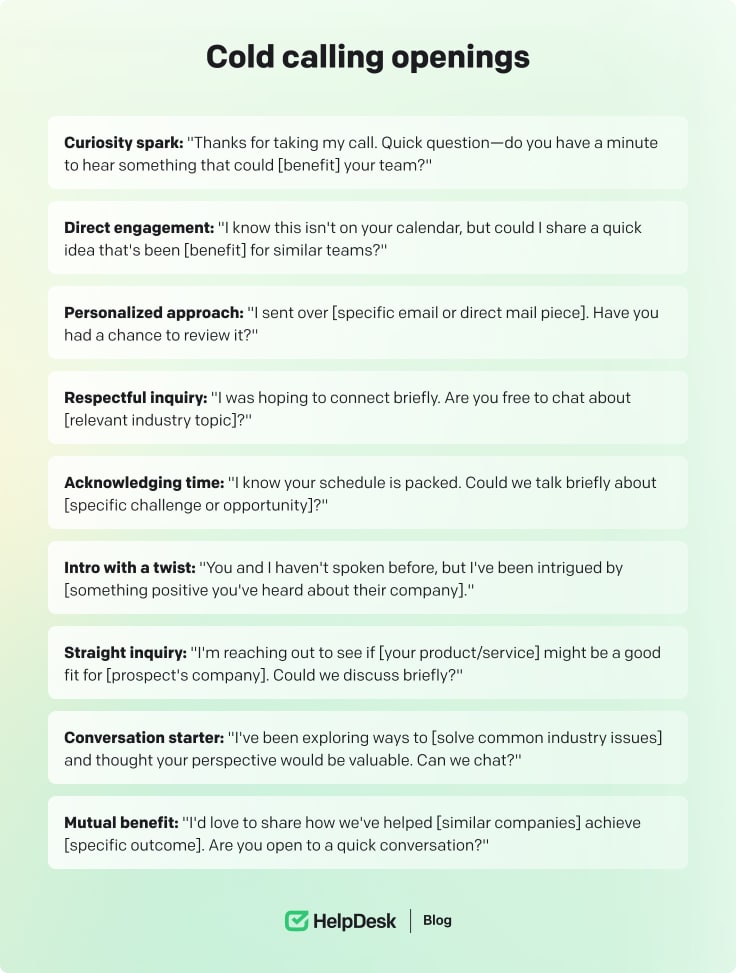
These openers are designed to capture attention by addressing relevance without immediately launching into a sales pitch. They’re intended to spark dialogue and engagement, leading to a more meaningful conversation.
You can also ask a question or make a statement encouraging the prospect to respond. A question or a statement should relate to their current challenges or goals, showing that you understand their situation and initiating a dialogue.
Emphasize pain points and value
During your cold call, emphasize the issues your prospect is experiencing. Then, mention how your product or service can provide tangible value. That part of the script should focus on demonstrating the benefits of your solution and aligning them with the prospect’s specific challenges.
Here’s how to do so:
-
Focus on benefits: Instead of listing features, highlight the benefits your prospect will experience. How will it make their job easier, save money, or improve efficiency?
-
Tell a story: Use anecdotes or case studies illustrating how similar clients have benefited from your solution. This makes the benefits more tangible and relatable to the prospect.
-
Address objections: Anticipate potential objections the prospect might raise and prepare responses highlighting the value proposition. This shows that you’ve considered and are prepared to address their concerns.
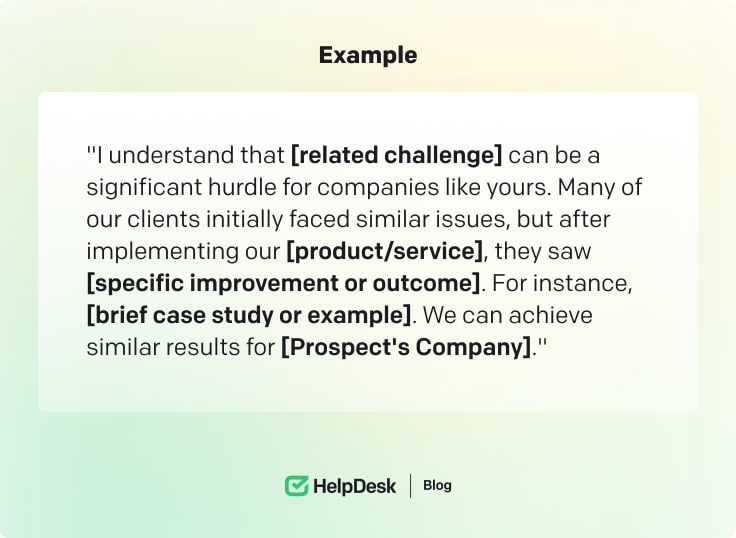
Throughout this part, aim to engage the prospect in a conversation rather than delivering a monologue. Ask open-ended questions to uncover more about their needs and how your solution can meet them.
Executing a successful cold call
Executing a successful cold call involves detailed preparation, practical communication skills, and meaningful prospect engagement.
Acknowledge the problem
-
Contextual opening: Start by establishing relevance based on your research. We’ve discussed openers above, and you can choose according to your requirements.
-
Align with priorities: Connect your solution to their priorities: “Given your focus on [specific initiative or concern], addressing [problem] seems crucial. Is that a priority for your team right now?”
-
Setting expectations: Manage expectations upfront: “In my experience with [similar roles/industries], addressing [common challenge] is often a top priority. Is this something you’re currently looking to improve?”
Here are some argument examples of different industries:
-
For a marketing solution: “I noticed you’re running Google ads for [specific service]. Are you aiming to attract more clients through these campaigns?”
-
For a sales automation tool: “Many sales teams use platforms like Salesforce to manage their pipelines. How does your team currently handle lead management?”
-
For an efficient tool: “Handling bookkeeping manually across multiple platforms can be time-consuming. How are you managing this process at [Prospect’s Company]?”
Automate your sales work. Resolve customer complaints quickly to increase brand loyalty. 🔥
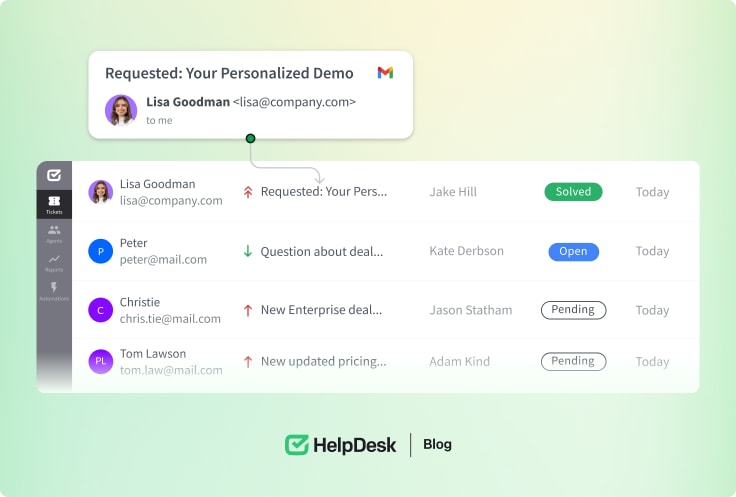
Utilize question stacking
Question stacking involves strategically layering questions to uncover deeper insights and commitments from the prospect.
-
Contextual setup: Provide context that leads into your main question: “Many businesses are struggling with [specific challenge]. How is your team currently addressing this?”
-
Reinforcement with examples: Use industry insights or examples to reinforce your question: “From my discussions with similar companies, [specific challenges] often arise. How are you tackling this issue internally?”
-
Customizing based on insights: Modify questions based on gathered insights or previous discussions: “Based on our past conversations, improving [specific process] was a priority. How has your approach evolved since then?”
It works because it encourages active participation and more profound responses, leading to a richer understanding of the prospect’s needs. By layering questions, you guide the conversation towards meaningful outcomes without overwhelming the prospect.
The easiest help desk system for a team like yours
Discover HelpDesk
Eliminate distractions during the call
To maximize your productivity during B2B cold calling, eliminate distractions and create a focused environment.
Among phones and technology, you can try:
-
Airplane mode and tabs: Put your phone on airplane mode to avoid interruptions from incoming calls or notifications. Close unnecessary browser tabs or applications on your computer to maintain focus on the conversation.
-
Avoid multitasking: Resist the temptation to multitask during the call. Dedicate your full attention to the prospect and their needs.
Also, prepare your workspace and maintain:
-
Quiet environment: Choose a calm environment where you can speak clearly and hear the prospect without distractions.
-
Materials ready: Have any necessary materials, such as your script, notes, and a pen or digital note-taking device, readily accessible.
Optimize your tone of voice
How you communicate during a cold call significantly impacts its success. You need to optimize your tone of voice:
-
Practice speaking with a clear, confident, and friendly tone. Avoid sounding scripted or overly formal. Your tone should convey enthusiasm and professionalism.
-
Practice your pitch and responses to common objections to build confidence in your delivery.
-
Take advantage of online resources, such as sales training courses or webinars. Focus on improving communication skills and cold-calling techniques.
-
Role-play scenarios with colleagues or mentors to simulate different types of calls. You should practice adjusting your tone and responses based on the prospect’s reactions.
Ask open-ended questions and listen actively
Craft purposeful questions that require more than a simple “yes” or “no” answer. Open-ended questions encourage the prospect to share goals related to their business.
- Examples: “Can you tell me more about your current [specific process or challenge]?” or “What are your main priorities when considering [your product/service]?”
Also, concentrate on what the prospect is saying without interrupting. Show genuine interest in their responses. Take notes during the call to capture key points, pain points, and specific details the prospect mentions.
Cold calling tips for success
You don’t need just an initial contact to successfully navigate cold calls. It’s about managing follow-ups, analyzing performance, and tracking key metrics.
1. Follow up and track progress
-
Book next steps: Ideally, aim to book the next meeting or call during your initial conversation.
-
Strategic follow-up: If you haven’t secured a commitment, leave a personalized voicemail or email reaffirming your interest and suggesting the next steps.
-
Strategic persistence: Follow up consistently without being intrusive. Timing is crucial. Adjust your approach based on the prospect’s responsiveness.
-
Communication: To maintain relevance and interest, each follow-up should add value or address a specific aspect of the client’s needs.
2. Improve your cold-calling strategy
-
Evaluate success metrics: Reflect on whether you successfully built a connection during the call. Fostering trust and continuing the conversation is essential.
-
Objective outcomes: Did you receive affirmative responses (yes) to progressing further in the sales cycle? Assess what worked and areas for improvement.
-
Learn from setbacks: If you didn’t achieve the desired outcomes, analyze what might have gone wrong. Was it timing, your pitch’s relevance, or the approach to handling objections?
-
Continuous improvement: Use each call as a learning opportunity. Adapt your approach based on feedback and insights gained from prospect interactions.
3. Track cold call KPIs and metrics
-
Call volume: Track the number of calls made per day or week.
-
Pickup rate: Measure how often prospects answer your calls. If pickup rates are low, adjust timing or tactics.
-
Qualifying conversations: Identify conversations where prospects express genuine interest or indicate potential for further discussion.
-
Scheduled meetings: Monitor how many calls lead to scheduled meetings or demos. This will highlight your ability to move prospects through the sales funnel.
-
Conversion rates: Calculate how many cold calls result in closed deals or progress to the next stage. This metric is directly related to your overall sales success.
Utilize the data for improvement, and try:
-
Performance benchmarking: Compare your KPIs over time to gauge improvement or identify areas needing adjustment.
-
Motivation and focus: Tracking metrics clarifies progress and motivates you to refine your approach for better outcomes.
-
Optimization opportunities: Analyze patterns in KPIs to optimize your strategy, such as adjusting call times, refining scripts, or more effectively targeting specific market segments.
Cold calling tools and resources
To level up your cold-calling game, you need the right tools and resources to comply. You should also understand the legal landscape to improve productivity and success rates.
Leverage a CRM for cold-calling success
A customer relationship management (CRM) system is essential for managing many contacts and keeping them personalized and informed.
You can also try tools like HelpDesk to centralize all customer interactions, track the progress of each lead, and get insights into customer behavior. Sales help desk allows sales reps to have all the necessary information at their fingertips. Also, each call is tailored to the prospect’s needs and previous interactions.
AI powers the ticketing system and offers text enhancements and multiple script templates. The CRM can also help segment prospects, prioritize high-value leads, and automate follow-ups, increasing the efficiency of cold-calling strategies. You can learn more here.
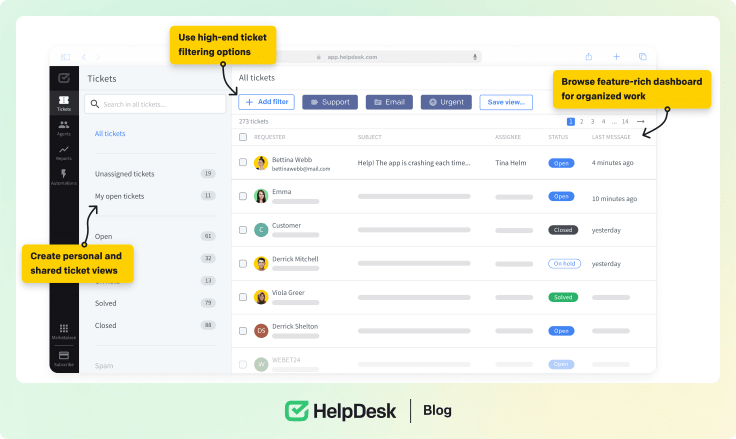
Use a sales dialer to save time and increase productivity
Using a sales dialer can greatly increase the number of daily calls, saving valuable time. It automates the dialing process, allowing sales reps to focus on speaking with prospects rather than dialing numbers manually.
For instance, Close’s Predictive Dialer can automatically call multiple numbers and connect the sales rep to the first call that gets picked up. The Predictive Dialer also offers real-time analytics and call recording features, which can be invaluable for training and improving call strategies.
Understand cold calling laws and compliance
Understanding the legal landscape of cold calling is necessary for businesses to operate responsibly and ethically. Cold-calling laws vary by country and region.
The standard regulations in the United States include the Telephone Consumer Protection Act (TCPA), which limits sales and marketing calls. The General Data Protection Regulation (GDPR) in Europe administers data privacy.
Sales reps must know these regulations to avoid hefty fines and legal repercussions. Key compliance measures include obtaining consent before calling, respecting “Do Not Call” lists, and providing opt-out options for recipients.
Your team should be well-versed in these laws to protect your business and build trust with prospects by representing respect for their privacy.
Summary
When executed strategically, cold calling can improve your sales and outreach efforts. Master the art of conversation and utilize the right tools to make your cold-calling approach successful.
Personalize your calls after research, create catchy scripts, and address your prospects’ pain points. Use systems like HelpDesk and sales dialers like Close’s Predictive Dialer to enhance productivity.
Integrating these elements into your sales strategy can improve success rates and build lasting connections. Watch your business grow as you connect with more qualified leads and drive higher conversion rates!


